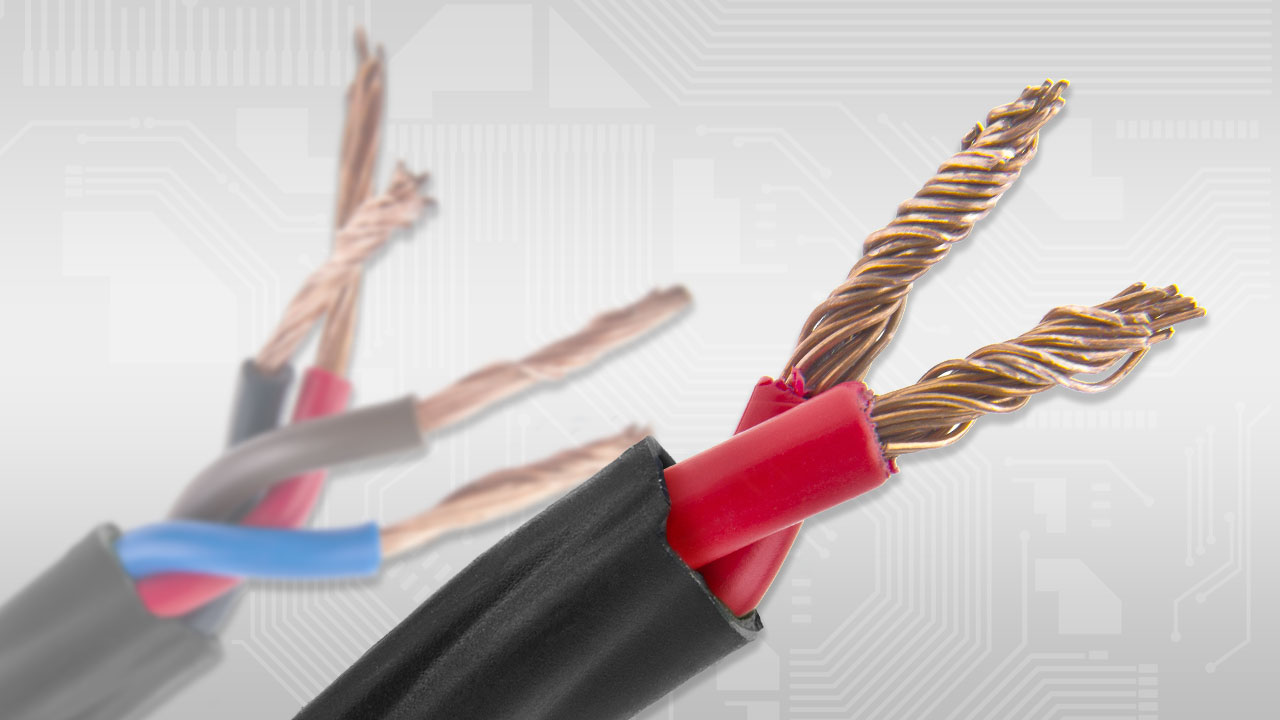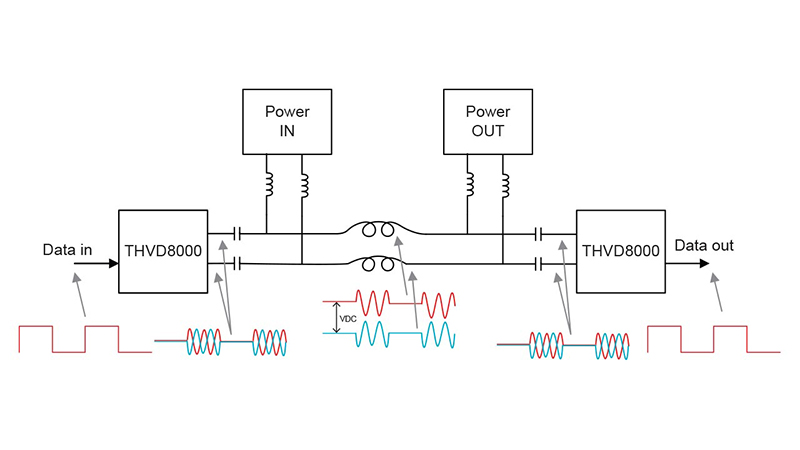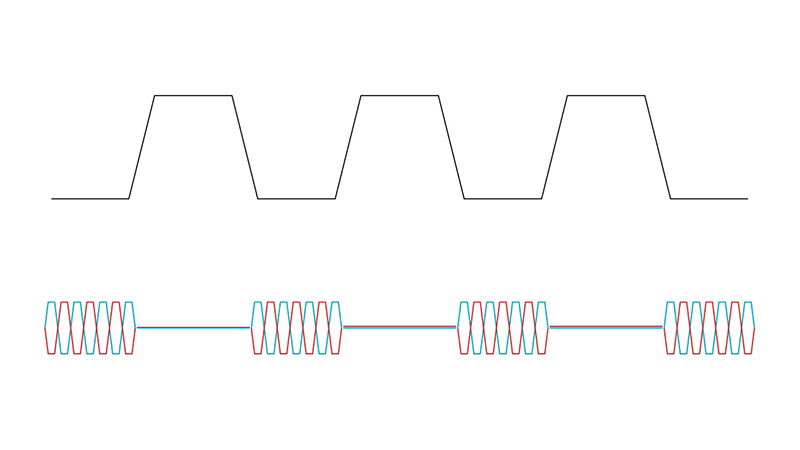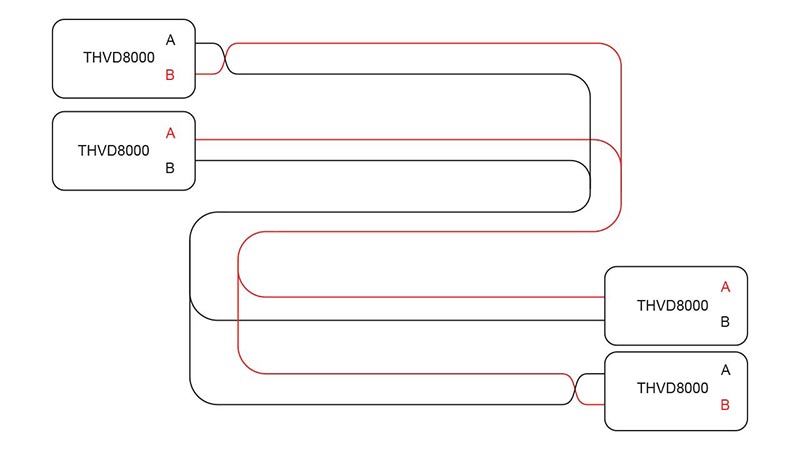SSZT295 june 2020 THVD8000
As I write this article, the Texas summer is in full swing, with temperatures reaching 95°F (32°C). I feel quite comfortable, however, thanks to my air conditioner. Sometimes it seems like a modern miracle; a simple push of a button on the thermostat and the room quickly and quietly takes on a more temperate climate. All the while, my outdoor unit is hard at work – far removed from the thermostat control unit and well out of earshot. While this reliable, long-distance connection might seem like magic, especially when the temperature peaks, it’s due to a relatively common communication standard, RS-485.
| Say goodbye to four-wire cables | |

|
The THVD8000 RS-485 transceiver with OOK modulation for power line communication modulates data onto existing power lines. This feature allows for power delivery and data communication to share a common pair of wires - resulting in a significant reduction of system costs. |
RS-485 is a differential signaling standard that, in addition to residential settings, is common in commercial heating, ventilation and air-conditioning (HVAC) systems, factory automation, grid infrastructure, appliances and motor drive industrial designs. These applications sometimes require transmitting RS-485 signals and power between nodes over long distances on the same cable. Conventional RS-485 systems transmit signals and power together using at least four wires: two wires for differential RS-485 signals and two wires for power and ground. The weight and cost of these long cables can increase system complexity and installation costs. With multiple wires, there is also a risk of system failure if they are connected incorrectly, further adding to system complexity.
Fortunately, four-wire solutions are no longer the only option when designing for RS-485 interfaces. RS-485 transceivers with on-off keying (OOK) modulation, such as the THVD8000, enable power-line communications – ultimately reducing the number of wires from four to two while increasing system performance and lowering overall cost. The THVD8000 delivers these benefits by integrating modulation and demodulation circuits, and bus I/O protection to pass IEC ESD 61000-4-2 contact discharge and IEC 61000-4-4 fast transient burst tests.
By integrating modulation and demodulation circuits, the THVD8000 can increase the frequency content of the baseband data being transmitted. This enables easier DC and AC coupling and system-side interfaces to standard universal asynchronous receivers-transmitters (typically used for RS-485) without any need for special encoding, which is useful in low-data-rate applications. By modulating RS-485 signals, as shown in Figure 1, these devices enable systems to transmit modulated signals over power lines so that only a single pair of wires is necessary. With the selection of wide carrier frequency ranges, the communication distance can be 1 km or more. This upgraded approach works well for both DC and AC power without the need for special coding in a microcontroller.
 Figure 1 RS-485 over Power-line Communication Using the THVD8000
Figure 1 RS-485 over Power-line Communication Using the THVD8000The OOK modulation of this device makes it possible to modulate a low-level input signal at the carrier frequency, as shown in Figure 2.
 Figure 2 OOK Modulation
Figure 2 OOK ModulationSince the signals are detected by amplitudes, OOK modulation operates in polarity-free mode, as shown in Figure 3. Swapping the A and B input/output (I/O) ports of RS-485 will not affect the communication, and polarity-free mode requires no manual or software setting. This feature greatly simplifies the installation procedure and eliminates the risk from connecting A and B I/Os incorrectly, which can impact system performance.
 Figure 3 Polarity-free Mode with the THVD8000
Figure 3 Polarity-free Mode with the THVD8000The next time you’re enjoying your air conditioner, remember that your RS-485 transceiver is working hard to keep you cool by sending commands to the control unit. With two-wire solutions like the THVD8000, these communications can be further simplified and system costs reduced - adding to that refreshing feeling from your trusty air conditioner as the temperatures outside inch closer to triple digits.
Additional resources
- Get started with the THVD8000 in your next RS-485 design with the application note, "THVD8000 Design Guide."
- Read the technical article, “Frequently asked questions and answers for RS-485 transceivers."
- View the online training video, “Interface Solutions for Industrial Applications.”